Most U.S. Adults Have Hearts Older Than Their Chronological Age: How Old Is Yours?

Many U.S. adults have a heart age older than their real age, highlighting the importance of early cardiovascular risk assessment and prevention strategies. A new study introduces a tool to help understand and communicate heart health risk more effectively.
A significant number of adults in the United States have a "heart age" that exceeds their actual age by several years, often by more than a decade. This discrepancy tends to be more pronounced among men, individuals with lower income or education levels, and those identifying as Black or Hispanic. A recent study led by Northwestern Medicine utilized a new online risk calculator that estimates a person's "heart age" based on common health data, including blood pressure, cholesterol levels, smoking status, and diabetes presence. This tool aims to make understanding cardiovascular risk more accessible, especially for younger adults who may not perceive themselves at immediate risk.
The study evaluated over 14,000 U.S. adults aged 30 to 79 from the National Health and Nutrition Examination Survey, excluding those with a prior history of heart disease. Results showed women had a mean heart age of 55.4 years versus their actual age of 51.3, while men had a mean heart age of 56.7 compared to an actual age of 49.7. Notably, nearly one-third of adults with a high school education or less had a heart age more than 10 years older than their chronological age. The gap was also significant among minority groups, with Black men having a heart age 8.5 years older than their actual age.
This research underscores the importance of early detection and preventative strategies, especially for younger populations who tend to underestimate their cardiovascular risk. The team's goal is to improve health communication by framing risk as an age, making it easier for individuals to grasp and act upon. The study emphasizes that many adults who could benefit from medication to reduce heart attack and stroke risk are currently not receiving these preventive treatments. Ultimately, identifying and addressing heart age discrepancies can help mitigate the persistent high rates of cardiovascular disease in the U.S.
The study, titled "PREVENT Risk Age Equations and Population Distribution in US Adults," highlights the need for proactive health management and aims to support more informed discussions between patients and healthcare providers. The findings suggest that understanding one's true heart age can be a powerful motivator to adopt healthier behaviors and pursue necessary interventions to lower long-term cardiovascular risk.
Stay Updated with Mia's Feed
Get the latest health & wellness insights delivered straight to your inbox.
Related Articles
Millions Face Loss of Healthcare Coverage Due to Stringent Reenrollment Policies on HealthCare.gov
A new study highlights how burdensome reenrollment policies on HealthCare.gov are leading to significant coverage loss among millions of Americans, risking increased uninsured rates.
Innovative AI and Extended Reality System Enhances Surgical Training for Residents
Mount Sinai researchers have created an AI-powered system using extended reality headsets to teach complex surgical procedures without instructors, demonstrating high success rates and potential to transform surgical education.
New Insights into the Tumor Microenvironment's Role in Nasopharyngeal Carcinoma Progression
Recent research uncovers the pivotal role of the tumor immune microenvironment in the progression of nasopharyngeal carcinoma, paving the way for personalized treatment strategies.
What Matters Most to Senior Citizens: Beyond Health Priorities
A groundbreaking study reveals that social activities and inclusion are the top priorities for senior citizens, surpassing even health concerns in outpatient care settings.



